The arguments for substance monism

Parmenides of Elea was an ancient Greek philosopher who founded the Eleatic school of thought, flourishing between the late 6th and early 5th centuries. We do not know everything about his life, but we know the basics. He was born into a wealthy family in Elea, a Greek-speaking city located in what is now southern Italy. In addition to his philosophy work, Parmenides was active in government and was credited with bringing structure and order to civic life.
He is also the central figure in Plato’s dialogue Parmenides, in which he and his student, Zeno of Elea, visit Socrates and converse with him. Though it is a wonderful dialogue, many classicists consider this interaction to be fictional. Regardless, the influence of Parmenides and the Eleatic school on philosophy is extremely significant with notable thinkers such as Zeno and Melissus of Samos being members of this school. Zeno — one of my personal favorites — developed a series of paradoxes concerning motion and time, all of which are influenced by Parmenides’ substance monism: the idea that reality is one substance that cannot be changed and is indivisible.
Parmenides’ only known work is a philosophical poem without a title, with many referring to it as On Nature. It was written in dactylic hexameter, the meter commonly used in epic poetry like Homer’s Iliad and Odyssey. As the title of this blog post suggests, only fragments of the poem have survived, making it difficult to interpret. There is also scholarly disagreement about the poem’s original structure — for example, the placement and length of Fragments, 2, 3, and 7 is debated, and some fragments are mere phrases, while Fragment 1 is significantly longer.
There are many translations of the poem, each reflecting different interpretive approaches. The translation by John Burnet, an early 20th-century classicist who is praised for his literal translation, has had a lasting influence in Presocractic studies.

Fragment 1
The car that bears me carried me as far as ever my heart desired, when is had brought me and set me on the renowned way of the goddess, which leads the man who knows through all the towns. On that way was I borne along; for on it did the wise steeds carry me, drawing my car, and maidens showed the way. And the axle glowing in the socket — for it was urged round by whirling wheels at each end — gave forth a sound as of a pipe, when the daughters of the Sun, hasting to convey me into the light threw back their veils from off their faces and left the abode of Night.
There are the gates of the ways of Night and Day, fitted above with a lintel and below with a threshold of stone. They themselves, high in the air, are closed by mighty doors, and Avenging Justice keeps the keys that fit them. Her did the maidens entreat with gentle words and cunningly persuade to unfasten without demur the bolted bars from the gates. Then, when the doors were thrown back, they disclosed a wide opening, when their brazen posts fitted with rivets and nail swung back one after the other. Straight through them, on the broad way, did the maidens guide the horses and the car, and the goddess greeted me kindly, and took my right hand in hers, and spake to me these words:
Welcome, O youth, that comest to my abode on the car that bears thee tended by immortal charioteers! It is no ill chance, but right and justice that has sent thee forth to travel on this way. Far, indeed, does it lie from the beaten track of men! Meet it is that thou shouldst learn all things, as well the unshaken heart of well-rounded truth, as the opinions of mortals in which is no true belief at all. Yet none the less shalt thou learn these things also, — how passing right through all things one should judge the things that seem to be.
The first fragment serves as a prologue to the rest of the text. Parmenides describes riding in a chariot drawn by horses, led by maidens who are “daughters of the Sun.” These divine figures guide him from the realm of darkness (“the abode of Night”) into the realm of light (Day) which represents a transition from ignorance to enlightenment. When the maidens lift their veils, it can be interpreted as gaining clearer vision for insight.
He describes arriving at the gates between Night and Day, which are guarded by a figure known as Avenging Justice (Dikē). She holds the keys to the gates and upholds the boundary between darkness and light — between illusion and truth. The maidens attempt to persuade her to open the gates so that Parmenides may pass through. Once he enters, Parmenides is greed by a goddess — known as Aletheia, the personification of Truth. She welcomes him and tells him that he must learn two paths. First, the way of well-rounded truth, which is eternal, unchanging, and understood through reason. Second, the way of opinion (doxa), which is the deceptive beliefs of morals predicated from sensory experience and illusion.
Understanding the distinction between the two paths is essential for Parmenides grasping the nature of reality. The allegorical journey in this fragment sets the stage for Parmenides’ metaphysics.

Fragments 2, 3
Come now, I will tell thee — and do thou hearken to my saying and carry it away — the only two ways of search that can be thought of. The first, namely that It is, and that it is impossible for it not to be, is the way of belief, for truth is its companion. The other, namely, that It is not, and that it must needs not be, — that, I tell thee, is a path that none can learn of at all. For thou canst not know what is not — that is impossible — nor utter it; … … for it is the same thing that can be thought and that can be.
Alluding back to the first fragment, the next two fragments expand on the two paths that the goddess Aletheia presents to Parmenides. The first path is that of truth, described by the statement: “It is, and it is impossible for it not to be.” Here, “It” refers to Being — that which exists. Parmenides argues that Being must exist, and its non-existence is impossible, because thinking or speaking about something requires that it is.
The second path, associated with illusion or false opinion, is: “It is not, and it must needs not be.” This path assumes the existence of non-Being, which Parmenides finds logically incoherent. One cannot know or even speak meaningfully about what does not exist — non-Being cannot be conceived. Therefore, only the first path, the way of Being, is one that is rooted in genuine knowledge and truth.
Fragment 4
Look steadfastly with thy mind at things though afar as if they were at hand. Thou canst not cut off what is from holding fast to what is, neither scattering itself abroad in order nor coming together.
Parmenides emphasizes rational thought over sensory experience in the pursuit of truth. Even if something appears distant or abstract, the truth of Being is still fully accessible through thought. For Parmenides, appearances cannot reveal true reality; only reason can.
When he says, “Thou canst not cut off what is from holding fast to what is,” he is arguing that Being cannot be divided, separated, or broken into parts. Being cannot be divided because that would imply the existence of non-Being between parts which would be impossible. Furthermore, if Being were to change, that would suggest it was once incomplete, or that it would become something else in the future. But change requires that part of what is to stop being (which would involve non-Being), and that something new must come into being (which would involve it coming from nothing and nothing cannot exist). Since Parmenides argues that nothing can come from non-Being, change is impossible.
Thus, Being must be whole, eternal, and unchanging.
Fragment 5
… It is all one to me where I begin; for I shall come back again there.
Parmenides succinctly states that all thought, no matter where it begins, result in the same truth about the reality of Being.
Fragment 6
It needs must be that what can be spoken and thought is; for it is impossible for it to be, and it is not possible for what is nothing to be. This is what I bid thee ponder. I hold thee back from this first way of inquiry, and from this other also, upon which mortals knowing naught wander two-faced; for helplessness guides the wandering thought in their breasts, so that they are borne along stupefied like men deaf and blind. Undiscerning crowds, who hold that it is and is not the same and not the same, and all things travel in opposite directions!
Parmenides reiterates that anything which can be spoken or thought must exist, because it is impossible to think or speak of what does not exist. He urges the reader to reflect on this insight: that speech and thought are only possible about Being. He adamantly rejects the notion that non-Being exists in any way, and insists that there can be no mixture of Being and non-Being. Akin to Aletheia, he criticizes those who rely on sensory experience and common beliefs, describing them harshly as “deaf and blind.” The common view of the world, held by the “undiscerning crowds,” is self-contradictory because it assumes that Being can both exist and not exist.
Fragment 7
For this shall never be proved, that the things that are not are; and do though restrain thy thought from this way of inquiry.
Nor let this habit by its much experience force thee to cast upon this way a wandering eye or sounding ear or tongue; but judge by argument the much disputed proof uttered by me…
The existence of non-Being cannot be proven, as it is inherently contradictory. Parmenides urges the reader not to pursue the path of non-Being, since it is fundamentally flawed from the start. He acknowledges that it is easy to fall into this mistaken thinking because of habits formed through sensory experience — when change and impermanence seem normal. However, these appearances are deceptive. For that reason, Parmenides insists that truth must be pursued through reason alone.
Fragment 8
… One path only is left for us to speak of, namely that It is. In this path are very many tokens that what is is uncreated and indestructible; for it is complete, immovable, and without end. Nor was it ever, nor will it be; for now it is, all at once, a continuous one. For what kind of origin for it wilt thou look for? In what way and from what source could it have drawn its increase? I shall not let thee say nor think that it came from what is not; for it can neither be thought nor uttered that anything is not. And, if it came from nothing, what need could had made it arise later than sooner? Therefore, must it either be altogether or be not at all. Nor will the force of truth suffer aught to arise besides itself from that which is not. Wherefore, justice doth not loose her fetters and let anything come into being or pass away, but holds it fast. Our judgment thereon depends on this; “Is it or is it not?” Surely, it is adjudged, as it needs must be, that we are to set aside the one way as unthinkable and nameless (for it is no true way), and that the other path is real and true. How, then, can what is be going to be in the future? Or how could it come into being? If it came into being, it is not; nor is it if it is going to be in the future. Thus is becoming extinguished and passing away not to be heard of.
Nor is it divisible, since it is all alike, and there is no more of it in one place than in another, nor to hinder it from holding together, nor less of it, but everything is full of what is. Wherefore it is wholly continuous; for what is, is in contact with what is.
Moreover, it is immovable in the bonds of mighty chains, without beginning and without end; since coming into being and passing away have been driven afar, and true belief has cast them away. It is the same and it rests in the self-same place, abiding in itself. And thus it remaineth constant in its place; for hard necessity keeps it in the bonds of the limit that holds it fast on every side. Wherefore it is not permitted to what is to be infinite; for it is in need of nothing; while, if it were infinite, it would stand in need of everything.
The thing that can be thought and that for the sake of which the thought exists is the same; for you cannot find thought without something that is, as to which it is uttered.
And there is not, and never shall be, anything besides what is, since fate has chained it so as to be whole and immovable. Wherefore all these things are but names which mortals have given, believing them to be true — coming into being and passing away, being and not being, change of place and alteration of bright colour.
Since, then, it has a furthest limit, it is complete on every side, like the mass of a rounded sphere, equally poised from the centre in every direction; for it cannot be greater or small in one place than another. For there is no nothing that could keep it from reaching out equally, nor can aught that is be more here and less there than what is, since it is all inviolable. For the point from which it is equal in every direction tends equally to the limits.
Parmenides reaffirms that there is only one valid path: the path in which It is. Expanding on his earlier claims, he explains that Being is uncreated, indestructible, wholly complete, unchanging, and eternal. Being cannot be created because creation would require Being to come from nothing — and nothing does not exist. Similarly, change is impossible, since it implies that something must cease to be and something new must come into being, which again would involve non-Being. Division, too, is ruled out, as it would require gaps or separation between parts necessitating something that is different than Being to perform these divisions. Moreover, because it is impossible to think or speak of what does not exist, all thought must concern what It is. Parmenides criticizes the average individual for not recognizing these concepts. They are misled by appearance and the name illusions like “coming into being and passing away” or “change of place and alteration of bright colour” as if they were real. For him, these are merely deceptive perceptions.
The Way of Belief (Editorial Label)
Here shall I close my trustworthy speech and thought about the truth. Henceforward learn the beliefs of mortals, giving ear to the deceptive ordering of my words.
Mortals have made up their minds to name two forms, one of which they should not name, and that is where they go astray from the truth. They have distinguished them as opposite in form, and have assigned to them marks distinct from one another. To the one they allot the fire of heaven, gentle, very light in every direction the same as itself, but not the same as the other. The other is just the opposite to it, dark night, a compact and heavy body. Of these I tell thee the whole arrangement as it seems likely; for so no thought of mortals will ever outstrip thee.
To clarify, most editors divide Parmenides’ poem into two parts: the Way of Truth and the Way of Belief — the two paths revealed to Parmenides by the goddess Aletheia. In the previous fragments — the Way of Truth — Parmenides explains what Being is (unchanging, eternal, and understood through reason). Now, he transitions to the Way of Belief, where he presents the mistaken views of mortals. The average people believe in a world composed of opposites, such as light and dark, or Being and non-Being. Parmenides explains that he will now lay out these mortal beliefs — not because they are true, but to show how they are rooted in illusion and based on deceptive sensory appearances.
Fragment 9
Now that all things have been named light and night, and the names which belong to the power of each have been assigned to these things and to those, everything is full at once of light and dark night, both equal, since neither has aught to do with the other.
Mortals have named things in order to assign opposites to everything. For example, light and night are terms used to represent polar opposites. As a result, the world appears to be made up of a mixture of these two opposing forces, when only Being exists.
Fragments 10, 11
And thou shalt know the substance of the sky, and all the signs in the sky, and the resplendent works of the glowing sun’s pure torch, and whence they arose. And though shalt learn likewise of the wandering deeds of the round-faced moon, and of her substance. Thou shalt know, too, the heavens that surround us, whence they arose, and how Necessity took them and bound them to keep the limits of the stars … … how the earth, and the sun, and the moon, and the sky that is common to all, and the Milky Way, and outermost Olympos, and the burning might of the stars arose.
Parmenides transitions to discuss the cosmology of the mortals, focusing on how elements in the universe — such as the sky, the sun, the moon, the stars, and the earth — came into existence. He introduces the concept of Necessity, a cosmic principle or divinity responsible for binding these elements in their specific places. For instance, the sun is described as having a “pure torch,” due to its constant brightness while the moon is said to have “wandering deeds,” referring to the moon’s changing phases. According to Parmenides, Necessity governs all these celestial bodies, keeping them in place, including the heavens and even Olympus, which is also subject to this organizing principle.
Fragment 12
The narrower bands were filled with unmixed fire, and those next them with night, and in the midst of these rushes their portion of fire. In the midst of these is the divinity that directs that course of all things; for she is the beginner of all painful birth and all begetting, driving the female to the embrace of the male, and the male to that of the female.
Parmenides continues by describing the cosmology of mortals. According to this view, the cosmos consists of bands or layers — some filled with pure fire, others with night. In between these bands, there appears to be a mixture between fire and night, as suggested by the phrase “in the midst of these rushes their portion of fire.” Regardless, at the center of this cosmic arrangement is a goddess who governs all. She is depicted as a director of the cosmos, responsible for initiating all birth and reproduction, uniting male and female forces.
Fragment 13
First of all the gods she contrived Eros.
Of all the gods, the first that the goddess of the cosmos created was Eros — the god of love and desire. This suggest that, at the very beginning, a governing female-like divine goddess produced a male-like counterpart, symbolizing the fundamental forces of reproduction and change in the cosmos.

Fragment 14
Shining by night with borrowed light, wandering round the earth.
In Parmenides’ time, scientific knowledge was far less advanced than it is today, and even basic concepts like the moon’s brightness being caused by the sun or the Earth’s rotation were not understood. Therefore, Parmenides likely means that mortals viewed the moon’s nighttime brightness as borrowed light from the sun. When he describes the moon as “wandering around the earth,” it probably refers to the moon’s movement across the night sky, as observed by those viewing it.
Fragment 15
Always looking to the beams of the sun.
It is difficult to determine exactly what this refers to due to the missing context from the rest of the text. One possibility is that it refers to the moon facing the sun’s beams, as it is the opposite of the sun and does not emit its own full brightness (according to the mortals).
Fragment 16
For just as thought stands at any time to the mixture of its erring organs, so does it come to men; for that which thinks is the same, namely, the substance of the limbs, in each and every man; for their thought is that of which there is more in them.
This fragment is largely understood to reflect Parmenides’ view of the mortals. He describes how thought it tied to the senses, referring to the organs as ‘erring’ (potentially implying that sensory experience leads to illusion rather than truth). He suggests that a person’s physical composition determines the nature of their thought, meaning the quality of one’s thinking is shaped by the mixture of bodily elements.
I will say that there is great scholarship that places this fragment in the Way of Truth section. The general argument is that this is Parmenides’ describing the intimate relationship between thought and the body because it has always only been meaning.
Fragment 17
On the right boys; on the left girls.
Once again, this fragment is largely understood to reflect Parmenides’ view of the mortals. The opposition between boys and girls highlights how the mortals conceptualize opposites that Parmenides finds to be an illusion.
Fragment 18
Fragment 18 remains unassigned, serving as a placeholder. This does not suggest that the fragment never existed, but rather reflects the editorial challenges involved in reconstructing fragmented texts.
Fragment 19
Thus, according to men’s opinions, did things come into being, and thus they are now. In time they will grow up and pass away. To each of these things men have assigned a fixed name.
In this final fragment, Parmenides highlights how the beliefs of mortals are rooted in the concept of change. Mortals assign names to things that change — such as growing up and passing away — thus giving this world of appearances a speakable existence. However, as Parmenides argument says, this understanding is based on illusion, as true Being is unchanging and eternal.

Conclusion
Though we only have fragments of Parmenides’ writings, there is enough to map out his entire argument. As one of the earliest substance monists, Parmenides’ thought has drastically influenced the entirety of Western philosophy. The ultimate question is: Is he right?
Leave a Reply